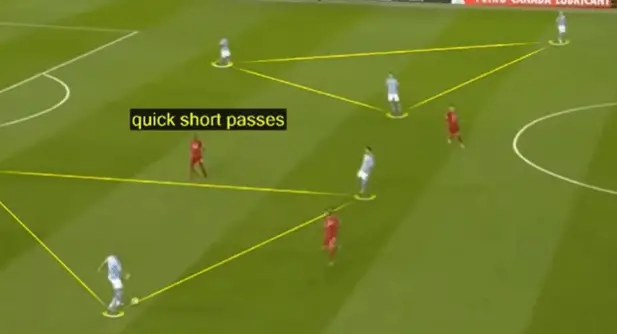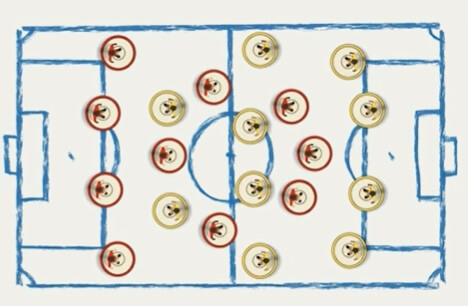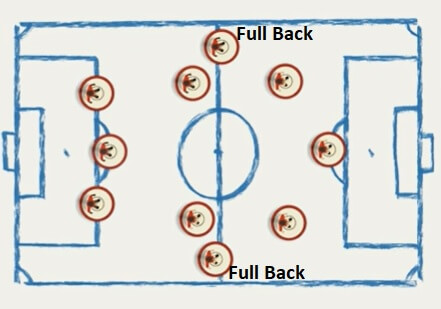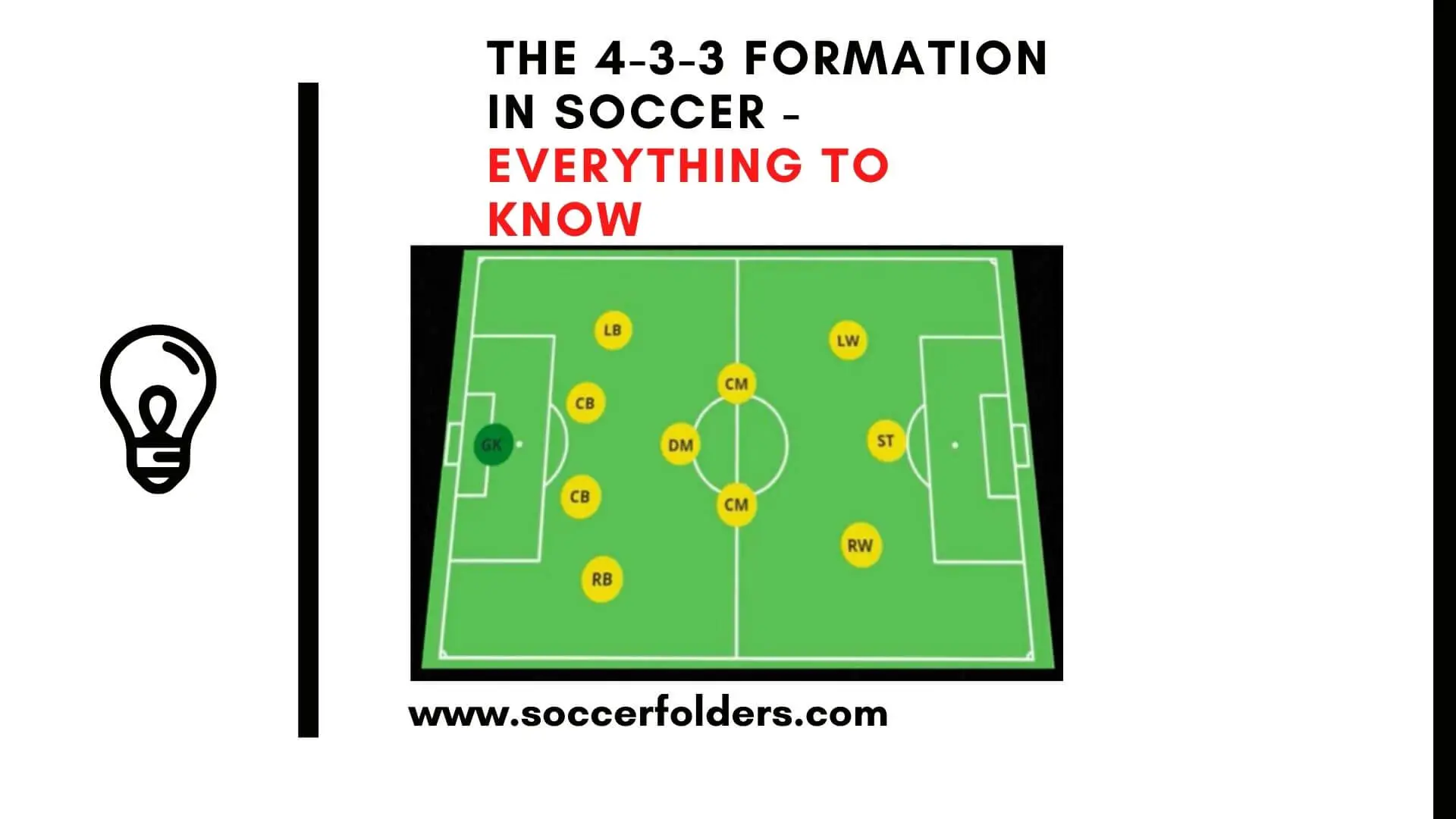Last Updated: Oct 15, 2023
The 4-3-3 formation in soccer has been the most used for the past few decades.
This formation has been used by some of soccer’s greatest managers and teams. Even in the modern game, big teams like Manchester City, Barcelona, Liverpool and PSG still use this formation and there is a reason for it.
But, why is this formation the most used in soccer? What are the advantages and disadvantages of this formation? Is this formation most suited to score more goals, keep possession or defend?
Do you want an answer to those questions? Well, get a snack and pay close attention because you are going to learn everything there is to know about the 4-3-3 soccer formation.
Let’s get started.
1. What Is The 4-3-3 Soccer Formation?
The 4-3-3 is an attacking formation often used by coaches who look to dominate the game. This formation also helps in the creation of natural triangles all over the pitch and always offers a simple passing option for the ball holder.

2. Who Invented The 4-3-3 Formation?
The 4-3-3 formation was first introduced by the Brazil national team during the 1962 World Cup.
Then, it was revolutionized by Johan Cruyff and modernized under Pep Guardiola in Barcelona.
But, why is this formation so popular?
3. Why Is 4-3-3 So Popular?
The 4 3 3 is the most popular formation in soccer because it has the potential to create numerical advantages in the centre of the field against the opposition.
The best way to control a game and ensure possession is to have a strong midfield.
Most teams understood this. This is why most of them tend to use the 4-3-3 formation as it allows them to have this extra midfielder.
This is very useful when you are playing against a 4-2-2 formation, for example. The 4 2 2 tends to only have two centre midfielders.
So, by having three centre midfielders, you can be sure to control and dominate the ball.
4. How Do You Play A 4-3-3 Formation?
Here is how you should play in a 4 3 3 formation in soccer:
- Midfielders should offer support to the defence when needed
- Midfielders should create chances and support the front three.
- Apply a massive amount of pressure on the opposition when you do not have the ball
- The front three must press the opposing backline and force them to make mistakes
- The midfielders must play long balls sometimes behind the opposing defence for the attackers
- 4 3 3 can also be used for counter-attacks
5. What Are The Strengths Of A 433 Formation?
Here are the strengths of a 433 formation:
- A numerical advantage in the centre of the pitch
- Tactical flexibility when out of possession
- Positional rotation
Numerical advantage: As mentioned earlier, the 4-3-3 gives you an extra player in the middle of the pitch and this can make a huge difference when you are facing a team with only two central midfielders.
Tactical flexibility: In a 4 3 3 formation, the wingers are aligned with the striker. But, sometimes, the wingers will play narrowly to keep the team’s shape compact and prevent the opposition from playing line-breaking passes through the middle.

Positional rotation: A very common rotation on the 4 3 3 formation is when the deep line midfielder drops down between the centre backs. This allows both full-backs the freedom to push forward into the attack. This gives a huge advantage to a team.

You have probably watched modern full-backs like Hakimi, Trent Alexander Arnold, or Marcelo. They all tend to push forward into the attack, bringing a numerical advantage to the forwards.
In Real Madrid, for example, whenever Marcelo and Dani Carvajal were pushing forward, Casemiro was always dropping back between the centre-backs.
6. 4-3-3 Formation Weaknesses
Here are the weaknesses of the 4 3 3 formations:
- If the front 3 miss on the pressing, it can cost a goal
- The striker can be isolated if both wingers stay wide
- Players need a lot of stamina for transitions
If the front three misses on the pressing, it can cost a goal: When your team has no possession of the ball, it’s vital that the front three press very high on the pitch. If this is not done properly, your team can quickly concede a goal.
Also, the front three must be able to recover and get back into shape as quickly as possible.
This is why Liverpool’s front three used to do a good job at pressing and getting back into shape on time(Mane, Salah and Firmino).
The striker can be isolated if both wingers stay wide: In a 4-3-3 formation, the attacking players are the striker and two wingers. But, most of the time, wingers play wide and leave the striker alone in the centre-forward position.
In this scenario, if the attacking midfielders don’t make a run into the box to support the striker, it might be difficult to make damage to the opposing side.
Players need a lot of stamina for transitions: Using a 4 3 3 formation means you are going to make a lot of transitions during the entire game. But, most of the time, full-backs won’t be able to get back to position on time to stop a counter-attack because of stamina issues.
So, you have to make sure your team works on improving stamina to perform in a 4 3 3 formation properly.
7. Is 4-3-3 The Best Formation?
The 4-3-3 is inevitably the best and most popular formation in soccer. The flexibility of this formation allows teams that use it to balance and use both an offensive and defensive strategy in the same game.
8. Best Formation Against 4-3-3
The 4-3-3 formation is a very popular and attacking formation in soccer. With three forwards, it provides a lot of attacking threats but can sometimes leave the defense exposed. As a result, knowing how to properly play against a 4-3-3 is crucial. Here are some tips on how to beat the 4-3-3 formation:
1. Match It
One effective way to neutralize a 4-3-3 is to match it with your own 4-3-3 formation. This evens out the midfield battle and prevents you from being overrun through the middle.
The key is to ensure your wide midfielders track back and help defend against their attacking fullbacks.
2. Go Narrow
A narrow formation like 4-4-2 or 4-2-3-1 can work well against a 4-3-3. This congests the middle of the pitch and forces their wingers to operate in less space. Just be wary of leaving space out wide for their fullbacks to advance into.
3. Press High
The 4-3-3 is reliant on short passing and retaining possession. Pressing high up the pitch can disrupt their build-up play and force hurried clearances.
To make it effective, your forwards and midfielders will need to press in a coordinated fashion.
4. Best Formation against 4-3-3
The best formation to use against a 4-3-3 is a 4-5-1. The five midfielders allow you to clog up the center of the pitch. Your defensive midfielder can also provide cover as your fullbacks mark their wingers.
On offense, the lone striker can press their center-backs. Keeping it compact and organized is key when facing the 4-3-3.
5. Use Overloads
Overloading one side of the field can create numerical advantages to exploit against a 4-3-3. Shifting your formation to advance down one flank pulls their defense out of position. A quick combination of play and crosses can then expose the spaces.
The 4-3-3 is designed to control possession and overwhelm defenses. But by using the right tactics and formation, you can minimize its threat.
Clogging the midfield, pressing high, and attacking down the flanks are all useful strategies against this popular modern formation.
Wrap Up
At the end of this article, it should be remembered that the 4-3-3 formation is one of the most used in soccer. Teams often use this formation to dominate possession of the ball and recover possession as fast as possible.
The key in this formation is the midfield. This is why it is considered the hardest position in soccer.
When this formation is used with the right players, it can be devastating.
I hope you have gained value from this article.
If you have any questions, consider leaving them in the comment section below.
Or you can directly contact Warren NZAMBI via the email contact@soccerfolders.com for any personalized tips.

